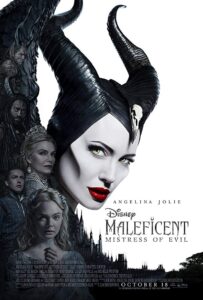Bonkers followup to hit PG-rated fairy tale is incoherent mess.


Back in 2014, following box office successes like Tim Burton’s “Alice in Wonderland” and Sam Raimi’s “Oz the Great and Powerful,” and a year before the live-action “Cinderella,” Disney delivered the unusual “Maleficent.” It was billed as the “untold” story of “Sleeping Beauty.” And in my largely positive review for a newspaper, I used words like “odd” and “weird” to describe the off-kilter approach to the material.
What worked then was the casting of Angelina Jolie, as the title witch, a dark fairy with dangerous magic. Maleficent’s backstory set the stage for the engaging tale of Aurora (Elle Fanning), the princess cursed by Maleficent to sleep until age 16, when only a true love’s kiss will awaken her. And somehow Disney managed to get a PG-rating even when the vicious Stefan clipped her wings, which Jolie commented in interviews was a “metaphor for rape.” In my review, I pointed out that under all the prosthetics (including, wickedly enhanced cheekbones), the gifted actress was given a character that conveyed a range of emotions—sadness, anger, and love. The last of which worked better than all the others.

That’s why with the sequel, coming five years after the first one, I was so surprised that we get very little context as to what has transpired during the time gap. The film opens with an almost nauseating aerial sweep over the various regions, showing us countryside, mountains, and into castles. It’s assumed that viewers are familiar with it all, having brushed up by watching the original. But by dumping us headlong into a fantastic world inhabited by humans and fairytale creatures, we lose the necessary elements that first endeared the otherwise scary Maleficent to us, chiefly that the love of her life had horribly wronged her. Maleficent’s motivations where, therefore, explained and her violent revenge somewhat justified.
The story we get in “Mistress of Evil” is rushed, simplistic palace intrigue. King John (Robert Lindsay) is delighted to hear of the engagement of his son Philip (Harris Dickinson taking over the role previously played by Brenton Thwaites) to Aurora. His hope is that the union will bring together the magical kingdom of the Moors with his human empire. But his wife, Queen Ingrith (Michelle Pfeiffer) isn’t so sure. She casts a suspect eye on the Moors, concerned about her husband’s gleeful naivety.

Like the Queen, Maleficent is concerned about the impending nuptials, but out of love for her adopted daughter, Aurora, she decides to attend a dinner with the King and Queen. Naturally, when the Queen pushes Maleficent’s buttons during the meal, things don’t go well. And when the King falls into a coma-like sleep, Maleficent is accused of another curse. Instead of calmly addressing the accusations and proving her innocence, Maleficent literally flies off the handle, only to be taken down by one of the Queen’s henchmen.
This is where things go from rushed and almost incoherent to downright strange. In time, Maleficent will discover that she may not be the only one of her kind, as she visits another realm hidden away from encroaching humankind. It’s that realm that offers the film’s most interesting elements, both visually and narratively. Maleficent awakens in some kind of cave fortress that is reminiscent of the castle design interiors from 1983’s “Krull.” As she groggily navigates this odd place, she questions her origins and purpose. Frankly, the entire movie should have been devoted to this journey of personal discovery; Aurora’s otherwise mundane and familiar love story gets in the way.

Those of you hopeful for a Pfeiffer vs. Jolie showdown will be a tad disappointed. Sure, there is a moment where the two square off, but it’s handled in such a mad-dash that very little tension is achieved. The frenzied final battle sequence is all dizzying nonsense, as characters bounce around like players in a video game. At one point, Aurora hangs out a castle window dangling precariously from a bunch of hastily tied bed linen and then scales the steps of the castle like an Olympic athlete to confront the Queen at precisely the right moment. It’s almost too much to take, as humans fight magical creatures with a combination of crossbow weapons and chemical or biological bombs that colorfully mask the actual carnage of the war. The whole thing is so ridiculous that any serious pathos is lost in the melee.

But the real tragedy is that Jolie never really emotes here. Her stone face, accentuated by artificially enhanced cheekbones and horns that grow out of her head, form a kind of mask preventing her from becoming a fully formed emotional being. Not so in the first film, where Jolie is great in that instant when she awakens to discover her wings have been horribly cut from her body by what she thought was her one true love. It’s a terrifying and effective standout scene. Nothing in this film comes close. All we get from Maleficent is a sly cut of the eyes or maybe an alluring gaze, which is fun, but just not enough.

And the coldness of the animated characters doesn’t help. The three fairies, Thistlewit (Juno Temple), Flittle (Lesley Manville), and Knotgrass (Imedlda Staunton) once again look like flying Moxie Girlz, the now discontinued little dolls with bulbous heads and skinny little bodies. It’s all very distracting, but weightless and ultimately having little lasting import.
“Maleficent: Mistress of Evil” is jumbled nonsense that palely reminds us of what barely made the first film work.
